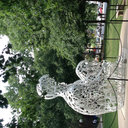HSCCC Separation of the Two Iridoid Glycosides and Three Phenolic Compounds from Veronica ciliata and Their in Vitro Antioxidant and Anti-Hepatocarcinoma Activities.
Keywords
Abstract
Five main compounds, including two iridoid glycosides (catalposide, verproside) and three phenolic compounds (luteolin, 4-hydroxy benzoic acid, 3,4-dihydroxy benzoic acid), were separated and prepared from the crude extract of Veronica ciliata by high-speed countercurrent chromatography. n-Hexane/n-butanol/water (1.5:5:5, v/v/v) was used for the separation of catalposide and verproside. n-Hexane/n-butanol/water (3:2:5, v/v/v) was used for the separation of luteolin, 4-hydroxy benzoic acid and 3,4-dihydroxy benzoic acid. The head-to-tail elution mode was used with a flow rate of 5.0 mL/min and a rotary speed of 800 rpm. Finally, a total of 1.28 mg luteolin, 6 mg 4-hydroxy benzoic acid, 2 mg 3,4-dihydroxy benzoic acid, 2 mg verproside and 10 mg catalposide with purities of 98%, 99.1%, 99.5%, 99.8% and 99%, respectively, were obtained from 200 mg of crude extract. In addition, their structure was identified using MS, ¹H-NMR and (13)C-NMR. To the best of our knowledge, this is the first report of the separation and purification of iridoid glycosides and phenolic compounds from V. ciliata by high-speed countercurrent chromatography (HSCCC). Among these compounds, luteolin, 4-hydroxy benzoic acid and 3,4-dihydroxy benzoic acid were separated from V. ciliata Fisch. for the first time. The results of the antioxidant activity show that protocatechuic acid and luteolin have strong antioxidant activity compared to 2,6-di-tert-butyl-4-methylphenol (BHT) and vitamin C (Vc). Five compounds also exhibited strong anti-hepatocarcinoma activities.


